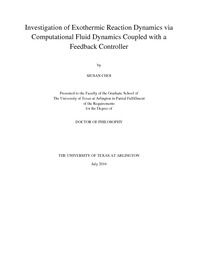
ATTENTION: The works hosted here are being migrated to a new repository that will consolidate resources, improve discoverability, and better show UTA's research impact on the global community. We will update authors as the migration progresses. Please see MavMatrix for more information.
Show simple item record
| dc.contributor.advisor | Dennis, Brian | |
| dc.creator | Choi, Siusan | |
| dc.date.accessioned | 2016-10-25T20:33:21Z | |
| dc.date.available | 2016-10-25T20:33:21Z | |
| dc.date.created | 2016-08 | |
| dc.date.issued | 2016-08-29 | |
| dc.date.submitted | August 2016 | |
| dc.identifier.uri | http://hdl.handle.net/10106/26166 | |
| dc.description.abstract | The control of reaction temperature under continuous flow conditions is important in a variety of chemical manufacturing industries. For many reactions, operating at off-design temperatures can result in the production of undesired products, reduced feedstock conversion and, in some cases, reduced catalyst lifetime. In many exothermic reactions, maintaining a desired set point temperature at high reactant flow rates becomes challenging if the chemical kinetics exhibit highly non-linear behavior. In these situations, the interaction between commonly used linear controllers and the physical system can lead to unexpected dynamic response and undesired swings in reaction temperature.
In this research, a computational model was developed to investigate the effect of a linear feedback controller on exothermic reaction dynamics. A Proportional-Integral-Derivative Control (PID) controller was implemented in MATLAB and coupled with the computational fluid dynamics software FLUENT. The system was first tested with a simple heat source term with a user selectable non-linearity. The PID controller was found to work well for low energy densities, but a steady oscillation in the reaction temperature was observed at high power densities where the non-linearity was large.
The software system was then used to study the interaction of a PID controller and a Fischer-Tropsch synthesis (FTS) reactor. Although many computational studies have been done for FTS, this is the first work to explore the effects of the controller on the dynamics of the model. A detailed kinetic model from the literature was used in FLUENT to simulate the FTS. Results for a steady-flow case were compared with published benchmark data to validate the FLUENT model. The coupled PID-FTS model was then run for different reactant flow rates and conditions similar to an experimental rig developed previously. The temperature response versus time at the center of the reactor was computed and compared with experiment data. At high flow rates, the computer model exhibited a temperature oscillation with a frequency close to that observed in the experiment. The results demonstrate that simulation can be used to replicate complex controller-chemical system interactions. This platform can be used in the future to test different control algorithms for FTS reactors before implementing them into the physical system and thus reduce the need to do numerous bench-top scale experiments in the laboratory. | |
| dc.format.mimetype | application/pdf | |
| dc.language.iso | en_US | |
| dc.subject | Exothermic reaction | |
| dc.subject | Computational fluid dynamics | |
| dc.subject | Simulation | |
| dc.subject | Feedback control | |
| dc.subject | PID | |
| dc.subject | Fischer-Tropsch synthesis | |
| dc.subject | Fixed bed reactor | |
| dc.title | Investigation of Exothermic Reaction Dynamics via Computational Fluid Dynamics Coupled with a Feedback Controller | |
| dc.type | Thesis | |
| dc.degree.department | Mechanical and Aerospace Engineering | |
| dc.degree.name | Doctor of Philosophy in Aerospace Engineering | |
| dc.date.updated | 2016-10-25T20:35:28Z | |
| thesis.degree.department | Mechanical and Aerospace Engineering | |
| thesis.degree.grantor | The University of Texas at Arlington | |
| thesis.degree.level | Doctoral | |
| thesis.degree.name | Doctor of Philosophy in Aerospace Engineering | |
| dc.type.material | text | |
Files in this item
- Name:
- CHOI-DISSERTATION-2016.pdf
- Size:
- 2.423Mb
- Format:
- PDF
This item appears in the following Collection(s)
Show simple item record


